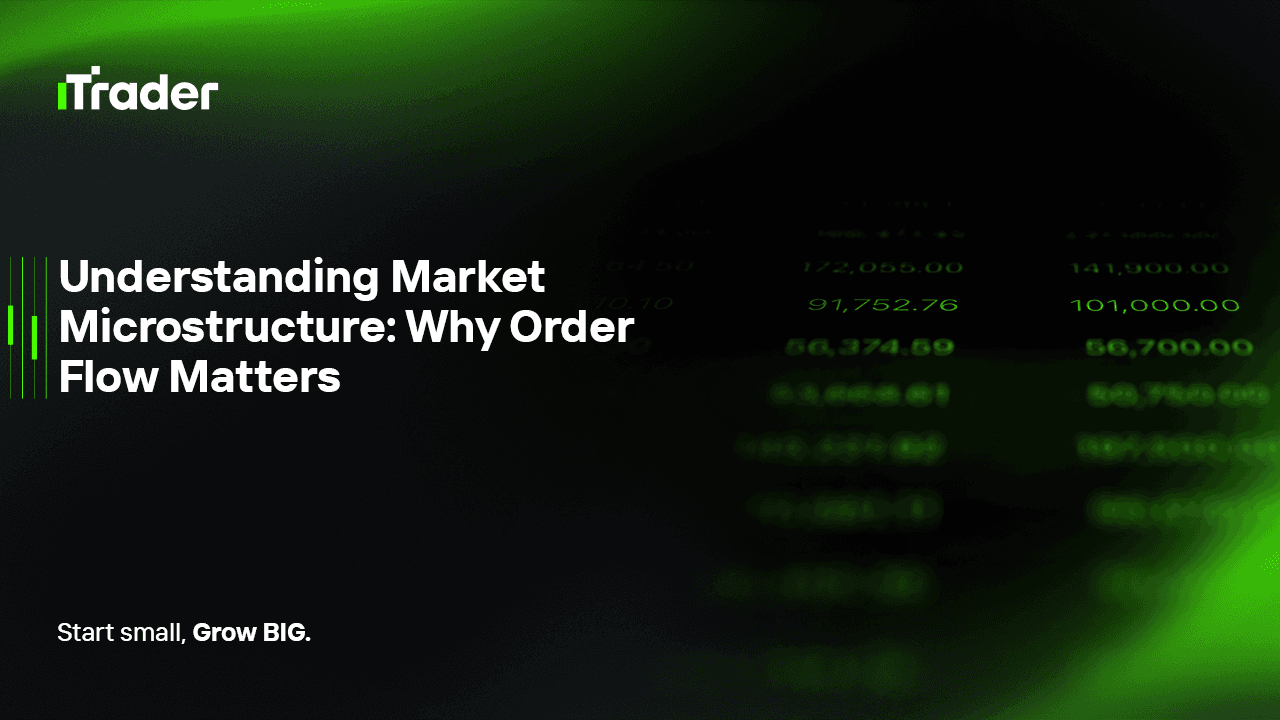2025-07-02
To the average trader, markets appear as a stream of prices moving up and down. But what causes those movements? What drives that next tick in the price of EUR/USD or S&P 500 futures?
The answer lies not in broad economic theory, but in the microstructure of the market—the mechanics that govern how orders are matched, how liquidity forms, and how information becomes priced in. At the center of this machinery is order flow: the detailed record of how buyers and sellers interact.

Understanding market microstructure and tracking order flow can provide traders with insights that traditional technical indicators simply cannot. Whether you’re trading manually or building an automated strategy, mastering this layer of market behavior is essential for precision and performance.
AI Summary:
What is market microstructure and why does order flow matter?
Market microstructure is the study of how financial markets operate at the transaction level, focusing on the mechanics behind trade execution, order types, liquidity, and price formation. Order flow refers to the real-time sequence of buy and sell orders and is a critical factor in understanding short-term price movements. By analyzing order flow, traders can identify institutional activity, assess market sentiment, and improve trade timing and execution. Understanding microstructure helps traders reduce slippage, interpret price action more effectively, and gain an edge in high-frequency or algorithmic trading strategies.
Market microstructure is the study of the processes and protocols through which trades are executed. It focuses on the real-time behavior of market participants and the infrastructure that facilitates price discovery.
Unlike macroeconomics, which asks why prices move, microstructure asks how they move—from the smallest change in a limit order book to the impact of execution speed.
Order flow is the net movement of buy and sell orders across the market. It reflects real-time sentiment and reveals which side—buyers or sellers—is more aggressive.
Every time a trade occurs, it represents a market order "hitting" a limit order resting in the book. For instance:
A consistent flow of aggressive buying or selling can push price in that direction—even without new information entering the market.
To understand microstructure, it’s essential to identify who’s placing the orders and why. Participants are not all equal—they have different motives, speeds, and strategies.
They provide liquidity by quoting both buy and sell prices, profiting from the bid-ask spread. They aim for frequent, low-risk trades.
These include hedge funds, mutual funds, and pension funds. They often split large orders into smaller chunks to avoid moving the market—a tactic called order slicing or iceberging.
Typically trade smaller sizes. Their impact on order flow is limited but can become significant in thin or fast markets.
HFT firms thrive on speed and microstructure inefficiencies. They use co-location and low-latency algorithms to anticipate short-term price shifts.
Price doesn't move just because of news or fundamentals—it moves when orders are executed. If buyers are more aggressive than sellers (i.e., market orders are lifting the ask), the price moves up.
This is why volume alone isn't enough—you must know whether the volume was executed on the bid or the ask. That directional intent is what gives order flow its predictive power.
Understanding microstructure and order flow can transform how you approach the market.
Rather than relying on lagging indicators, traders can observe real-time buyer/seller aggression to enter on confirmation, not prediction.
Watching where large passive orders rest in the book (and where they disappear) can reveal hidden support/resistance levels.
Unusual surges in one-sided order flow, iceberg orders, or spoofing patterns often hint at large player involvement.
Quantitative strategies that integrate order book dynamics and trade prints often outperform those based solely on price and volume.
These tools help traders make informed decisions in fast-moving markets, where milliseconds matter.
Many modern trading strategies—especially in prop trading firms—are built on microstructure principles.
While powerful, interpreting order flow isn’t without challenges:
As markets evolve, so do microstructure dynamics. Increasing automation, fragmentation (across multiple venues), and the rise of crypto markets are reshaping how order flow is interpreted.
New frontiers include:
For traders and firms that adapt, microstructure offers one of the clearest competitive advantages in the market.
In trading, timing is everything—and timing depends on structure. While most strategies operate at the macro or technical analysis level, it’s the microstructure that determines the fine print of success.
Order flow analysis gives traders the ability to see beneath the surface of candles and indicators, revealing the intent behind every price movement. By learning to read the market’s internal language, traders gain sharper entries, smarter exits, and the capacity to compete in the most data-driven segment of the financial world.
Whether you're developing an algorithm, executing manually, or running a prop desk, understanding market microstructure is no longer optional—it's foundational.
© 2025 iTrader Global Limited | 公司注册号 15962
iTrader Global Limited 位于科摩罗联盟安儒昂自治岛穆察姆杜 Hamchako,并受科摩罗证券委员会(Securities Commission of the Comoros)许可及监管。我们的牌照号为 L15962/ITGL。
iTrader Global Limited 以“iTrader”作为交易名称,获授权从事外汇交易业务。公司的标志、商标及网站均为 iTrader Global Limited 的专属财产。
风险提示: 差价合约(CFD)交易因杠杆作用存在高风险,可能导致资金快速亏损,并非适合所有投资者。
交易资金、差价合约及其他高杠杆产品需要具备专业知识。
研究显示,84.01% 使用杠杆的交易者会遭受亏损。请务必充分了解相关风险,并确认在交易前已做好承担资金损失的准备。
iTrader 特此声明,不会对任何个人或法人在杠杆交易中产生的风险、亏损或其他损失承担全部责任。
本网站提供的新闻及信息仅用于教育目的。用户应独立且审慎地作出金融决策。
限制条款: iTrader 不会向法律、法规或政策禁止此类活动的国家或地区居民提供本网站或相关服务。若您居住在限制使用本网站或服务的司法管辖区,您有责任确保遵守当地法律。iTrader 不保证其网站内容在所有司法管辖区均适用或合法。
iTrader Global Limited 不向以下国家/地区的公民提供服务,包括但不限于:美国、巴西、加拿大、以色列及伊朗。